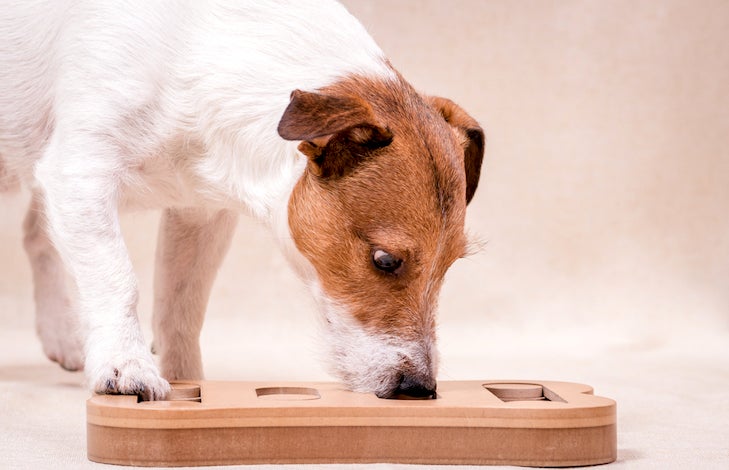For most dogs, the mere sight of the food dish can elicit barking and bouncing around the kitchen. Putting the bowl down while your dog is acting up encourages bad manners and wastes a golden opportunity. You can use your dog’s food to provide enrichment, fight canine boredom, teach good behavior, and build your bond. Take advantage of the power of kibble and turn dinner into an educational period by training at mealtime.
Make Your Dog Work for Dinner
Many dogs act up because they’re bored. Without enough physical exercise and mental stimulation, dogs will make their own fun, often by chewing shoes and furniture or other nuisance behaviors. When they scarf down their meals in a minute or two, no enrichment occurs. Instead, try placing your dog’s kibble in a slow feeder bowl or a puzzle toy. That will keep your pet busy for far longer, force them to use their brain as well as their teeth, and teach them positive ways to pass the time.
Slow feeders are bowls with obstacles inside so your dog can’t scoop up more than a few pieces of kibble at a time. They make your dog eat slower, ideal for pups who gulp down their food; eating too quickly puts dogs at risk for choking, vomiting, and bloat. Plus, the longer it takes your dog to eat their own meal, the less time they will have to bother you as you eat yours. Giving your dog something to do while you eat is also a great way to reduce problem begging. If you feed your dog wet food, such as canned or raw, insert it into a chew toy like a Kong. Freeze the toy for an even greater challenge.

Food-dispensing puzzle toys require your dog to manipulate them in some way to get at the food inside. Your dog might have to roll the toy over, move a lever, or lift a flap. You can even make your own dog puzzle toys to challenge your pup’s brain and keep them entertained. Or try a game of kibble hide-and-seek. Toss your dog’s dinner in the grass or on a snuffle mat and let them search for it. Alternatively, hide food around your home. Start by placing small piles in obvious locations and pointing them out to your pup. Then slowly increase the difficulty so your pet can use their nose to sniff out their meal.
Hand Feed Your Dog
Another way to make dinnertime work for you is to hand feed your dog. This is easiest with kibble, but if you give your dog wet food, you can use a spoon. Hand feeding builds your bond with your dog, which is especially useful with a new pet. If food comes directly from you rather than a dish, your pet learns that you are the source of good things; they will form a positive association between you and the food they already love. Plus, hand feeding encourages focus, which is a valuable skill.

Hand feeding can also become a training session where your dog must earn every morsel. Practice with behaviors your dog already knows or try teaching new ones. For example, every sit can earn a piece of kibble. You can also save some of the meal to use throughout the day. If your dog performs a behavior you want to reinforce, like lying quietly while you watch TV, give them some kibble.
You can even feed meals on the run. Fill a treat pouch with your dog’s rations and reward loose leash walking skills on your daily walks. Just be aware of your dog’s hierarchy of rewards. If there are distractions competing with you for your dog’s attention, then it’s time to bring out the special treats like cheese or liver.
Use the Food Dish as One Big Reward
If you don’t have time to feed your dog one piece at a time, take advantage of the jackpot the food dish represents. Why give your dog such a huge reward in exchange for nothing? Instead, ask for a behavior before you put down the bowl. It could be something as complex as four or five tricks in a row. But for an overly excited pup, a calm behavior is best, as it helps foster emotional self-control in your dog.

To train calm behavior at mealtimes, only feed your dog when they’re relaxed. Giving them their meal while they’re out of control rewards that behavior, which will progressively worsen. Instead, ask your dog to sit or lie down before you lower the dish to the ground. If they pop out of position, lift the dish and place it behind your back. Then ask for the calm behavior again, repeating the process until you can put the dish on the ground and release your dog to eat.
There are so many ways to make your dog’s meals work for you. Don’t squander such a valuable resource. Instead, use the power of kibble or wet food to provide your dog with more than nourishment; give them enrichment, mental exercise, training, and bonding instead. You will have a happier, better-behaved dog in no time.

